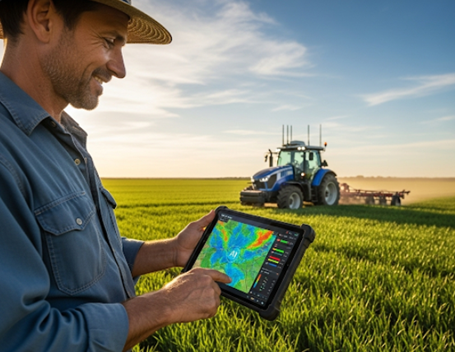
Part I: Cultivating the Future: How Generative AI is Transforming Agriculture
Generative AI is no longer a futuristic concept; it’s a powerful tool actively reshaping global industries. For agricultural sciences, this technology presents a pivotal opportunity to enhance efficiency, sustainability and innovation. We must now ask: how is generative AI revolutionizing agricultural academics, research and on-the-ground industry practices?
| Key Questions |
| How will generative AI change the way we teach agriculture? |
| What research breakthroughs can AI help us unlock? |
| How are farms and agribusinesses using these tools today? |
Smarter Learning: Generative AI in the Agricultural Classroom
The integration of generative AI into academics is transforming agricultural education from the ground up. Instead of static textbook examples, students can now use AI to simulate complex scenarios, from crop disease outbreaks to market volatility. This creates a dynamic, problem-based learning environment that prepares them for real-world challenges.
This shift moves educators from lecturers to facilitators of inquiry. Their role becomes guiding students on how to ask the right questions and critically evaluate the outputs from AI models. Consequently, we are fostering a new generation of agricultural professionals who are not just knowledgeable but also adaptable and tech-savvy.
Accelerating Discovery: AI’s Role in Agricultural Research
In the world of agricultural research, time is a critical and often limiting factor. Generative AI is shattering these limitations by drastically accelerating the pace of discovery. It can analyze massive genomic datasets to identify climate-resilient crop varieties in a fraction of the time traditional methods would take.
| Task | Traditional Timeline | AI-Powered Timeline |
| New Crop Variety Breeding | 10-12 years | 5-7 years |
| Pest Outbreak Modeling | Weeks to months | Days to hours |
| Soil Health Analysis | Days (lab work) | Minutes (sensor data) |
Furthermore, these tools empower researchers to develop more sophisticated climate models or optimize resource allocation for entire regions. By simulating the long-term effects of different farming practices, generative AI provides invaluable foresight. This allows us to test hypotheses virtually before committing to costly and lengthy field trials.
From Lab to Field: Generative AI in the Agri-Food Industry
The practical applications of generative AI are already taking root across the agri-food industry. On the farm, AI-driven platforms can generate hyper-specific irrigation and fertilization plans based on real-time data from drones and soil sensors. This precision agriculture minimizes waste, reduces environmental impact and boosts crop yields.
Beyond the farm gate, generative AI is optimizing supply chains by creating models that predict demand, reduce spoilage and improve logistics. Agribusinesses use these tools to generate reports, create marketing content for new products and even design more sustainable packaging solutions, showcasing the technology’s versatility.

Takeaway
Generative AI is a transformative force in agricultural sciences, fundamentally altering how we learn, discover and produce. Embracing these tools is not just about staying current; it’s about building a more resilient and productive future for agriculture. The challenge ahead is to ensure this technology is deployed thoughtfully and equitably.
Sources
- Tian, F., & Zhou, J. (2025). Drones can more efficiently measure the health of corn plants. College of Agriculture, Food and Natural Resources – University of Missouri. Retrieved from cafnr.missouri.edu/stories/drones-can-more-efficiently-measure-the-health-of-corn-plants-study-finds/?utm_source=chatgpt.com
- Krohn, J. (2025). Tracking invasive pear trees with the help of AI. Show Me Mizzou – University of Missouri News. Retrieved from showme.missouri.edu/2025/tracking-invasive-pear-trees-with-the-help-of-ai/?utm_source=chatgpt.com
- Aijaz, N., Lan, H., Raza, T., et al. (2025). Artificial Intelligence in Agriculture: Advancing Crop Productivity and Sustainability. Journal of Agricultural and Food Research, 20, 101762. doi.org/10.1016/j.jafr.2025.101762
Useful Resources
- USDA National Institute of Food and Agriculture (NIFA): Explore federally funded research initiatives and data on AI in agriculture. USDA NIFA | National Institute of Food and Agriculture
- AgFunderNews: Stay current with the latest news and investments in agricultural technology and startups. AgFunderNews – reporting on the evolution of food and agriculture
- CAFNR’s Agricultural Experiment Station (AES): Discover the groundbreaking research happening right here. The AES is the hub for innovation, showcasing how CAFNR faculty are leading the development and application of new agricultural technologies, including data-driven AI solutions. Missouri Agricultural Experiment Station.
FAQs
- Is generative AI going to replace farmers? No, it’s a tool to augment their expertise. AI can manage data and automate tasks, allowing farmers to focus on strategic decision-making.
- What skills do students need for a career in AI-driven agriculture? Students need a blend of agricultural science, data analysis and an understanding of AI systems.
- Is AI in agriculture affordable for small farms? While initial costs can be a barrier, the development of more accessible, subscription-based AI platforms is making the technology increasingly available to smaller operations.
Future Inside CAFNR Articles for this Series
| Topic | Why this Topic? |
| Gen AI in Food & Nutritional Sciences | Explores how AI is personalizing nutrition, optimizing food production and accelerating research into dietary health. |
| Gen AI in Exercise Science | A look into AI’s role in creating customized fitness plans, analyzing biomechanics and advancing sports performance research. |
| Gen AI in Natural Resources | Focuses on how AI helps manage ecosystems, model climate change impacts and promote sustainable conservation efforts. |
Produced by:
Daniel Credeur, PhD
Associate Teaching Professor in Food, Nutrition and Exercise Sciences
Provost’s AI Fellow for CAFNR